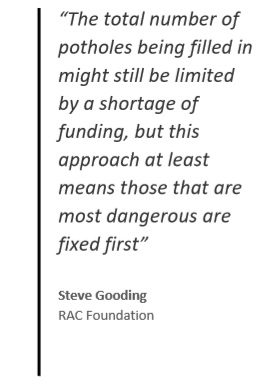
Analysis by the RAC Foundation shows that local highway authorities are increasingly adopting a ‘risk-based’ approach to fixing potholes.
Based on data received from 190 of the 207 local highway authorities in Britain, the RAC Foundation says 75% (142) had already moved to a risk-based approach by autumn 2018.
A further 15 (8%) said they were about to move to the new system or were reviewing their existing practices.
The ‘risk-based’ approach is recommended as best practice by the UK Roads Liaison Group, a collaboration of both national and local government.
 Under this approach, councils not only take into consideration the size, width and depth of a pothole – but also the type of road, the volume of traffic the road carries and the mix of road users.
Under this approach, councils not only take into consideration the size, width and depth of a pothole – but also the type of road, the volume of traffic the road carries and the mix of road users.
The RAC Foundation analysis also shows almost all authorities still set minimum investigation levels – based on depth and width measurements – below which they won’t assess potholes, nor assign response times based on the dangers they pose.
While 37 local highway authorities said they would investigate when a pothole was between 20-30mm deep, 26 others said the depth had to be at least 50mm or more.
Steve Gooding, director of the RAC Foundation, said: “It is good to see that the vast majority of local highway authorities are adopting the best practice ‘risk-based’ approach recommended by the UK Roads Liaison Group, which is putting the risk to road users front and centre alongside the potential for a defect to develop into a bigger structural problem.
“The total number of potholes being filled in might still be limited by a shortage of funding, but this approach at least means those that are most dangerous are fixed first.”
In terms of repair times, the analysis reveals the quickest-acting councils in Great Britain aim to fill in the most severe potholes in their roads within minutes.
Cumbria, Flintshire and South Lanarkshire aim to act ‘immediately’ to repair potholes that pose the greatest risk to the state of the road and the safety of drivers and riders.
The most common response time to the most urgent problems is two hours, with 79 councils looking to patch up the road within this period.
At the other end of the scale it can take some councils three or more days to intervene.
Steve Gooding added: “It is understandable that large rural authorities set themselves longer response times, simply as a result of having to travel further to effect repairs, but motorists might still be surprised to see such a wide variation across the country.
“Those particularly vulnerable to potholes – cyclists and motorcyclists – might ask whether the speed of pothole investigation should be based solely on the risk to users.”
Speaking from personal experience, potholes in my area do get seen to very promptly, even in light-trafficked, slow-speed residential areas.
Apart from ‘natural’ potholes, there is still the problem however of poor reinstatements, trenches and manhole cover surrounds, which to the motorist may still be felt as ‘potholes’. One other gripe – surface dressing a carriageway without first attending to pre-existing defects- it doesn’t take long for them to reappear and is like papering over cracks.
Hugh Jones, Chreshire
+1
Some ten years ago or so I read an article or paper relating to highways by some authority and in it they change the depth of a pot hole from 10 cm to 15 cm before it would be deemed to be a pothole. It seems odd to me that they are talking about potholes that are up to a mere 50 mm deep as those would be the depth of the upper surfaces only and not that deep but more frequently found on our roads.
If more safe following on distance was instructed to drivers then more drivers would have distance, sight, time and space in which to avoid hitting them. Plus where potholes are known to be a slower speed should be adopted and in the event of hitting one that slower speed would reduce the possible damage and or injury that could possibly be caused.
R.Craven
0